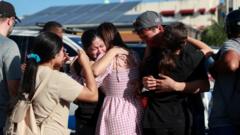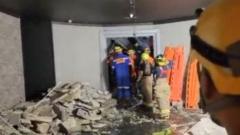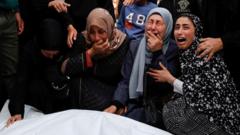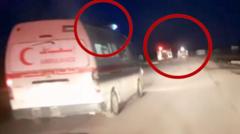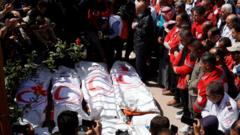The aftermath of a deadly incident involving Israeli forces and emergency responders in Gaza reveals alarming concerns over humanitarian safety amidst ongoing conflict.
Eyewitness Accounts Uncover Tragic Attack on Gaza Medics

Eyewitness Accounts Uncover Tragic Attack on Gaza Medics
Two witnesses describe an Israeli military strike on ambulances and rescue workers that resulted in multiple fatalities.
In the early hours of March 23, a convoy of ambulances and a fire truck operated by the Palestinian emergency services paused in Rafah, a city in southern Gaza. Their purpose: to locate paramedics who had earlier embarked on a rescue mission but subsequently vanished. As they approached the last-known location of a missing ambulance, Israeli soldiers who were stationed about 50 meters away opened fire without warning, as per eyewitness accounts from two men who were detained by those same troops.
Munther Abed, a 27-year-old volunteer paramedic, reported that he was taken into custody after surviving an initial assault on another ambulance, which resulted in the fatalities of two colleagues. Meanwhile, Dr. Saeed al-Bardawil, a 55-year-old doctor, recounted how he had been intercepted alongside his son en route to a fishing trip at approximately 4:45 a.m.
In a separate interview, both men detailed the harrowing moments they endured, during which 15 rescue workers were later discovered dead by the United Nations. The bodies—eight from the Palestine Red Crescent Society, six from Gaza’s Civil Defense, and one from the UN—were uncovered in a mass grave not far from their partially buried vehicles. The UN has implicated Israel in this incident, accusing its forces of intentionally targeting and killing these emergency personnel.
The accounts of Abed and al-Bardawil provide troubling corroboration of these allegations, although independent verification remains elusive. However, their testimonies align closely with footage retrieved from a deceased paramedic’s cellphone, which depicts the moment of the barrage hitting the ill-fated convoy as daybreak approached. This adds to the complexity and urgency of the concerns regarding the safety of humanitarian workers amidst growing violence in the region.
Munther Abed, a 27-year-old volunteer paramedic, reported that he was taken into custody after surviving an initial assault on another ambulance, which resulted in the fatalities of two colleagues. Meanwhile, Dr. Saeed al-Bardawil, a 55-year-old doctor, recounted how he had been intercepted alongside his son en route to a fishing trip at approximately 4:45 a.m.
In a separate interview, both men detailed the harrowing moments they endured, during which 15 rescue workers were later discovered dead by the United Nations. The bodies—eight from the Palestine Red Crescent Society, six from Gaza’s Civil Defense, and one from the UN—were uncovered in a mass grave not far from their partially buried vehicles. The UN has implicated Israel in this incident, accusing its forces of intentionally targeting and killing these emergency personnel.
The accounts of Abed and al-Bardawil provide troubling corroboration of these allegations, although independent verification remains elusive. However, their testimonies align closely with footage retrieved from a deceased paramedic’s cellphone, which depicts the moment of the barrage hitting the ill-fated convoy as daybreak approached. This adds to the complexity and urgency of the concerns regarding the safety of humanitarian workers amidst growing violence in the region.


